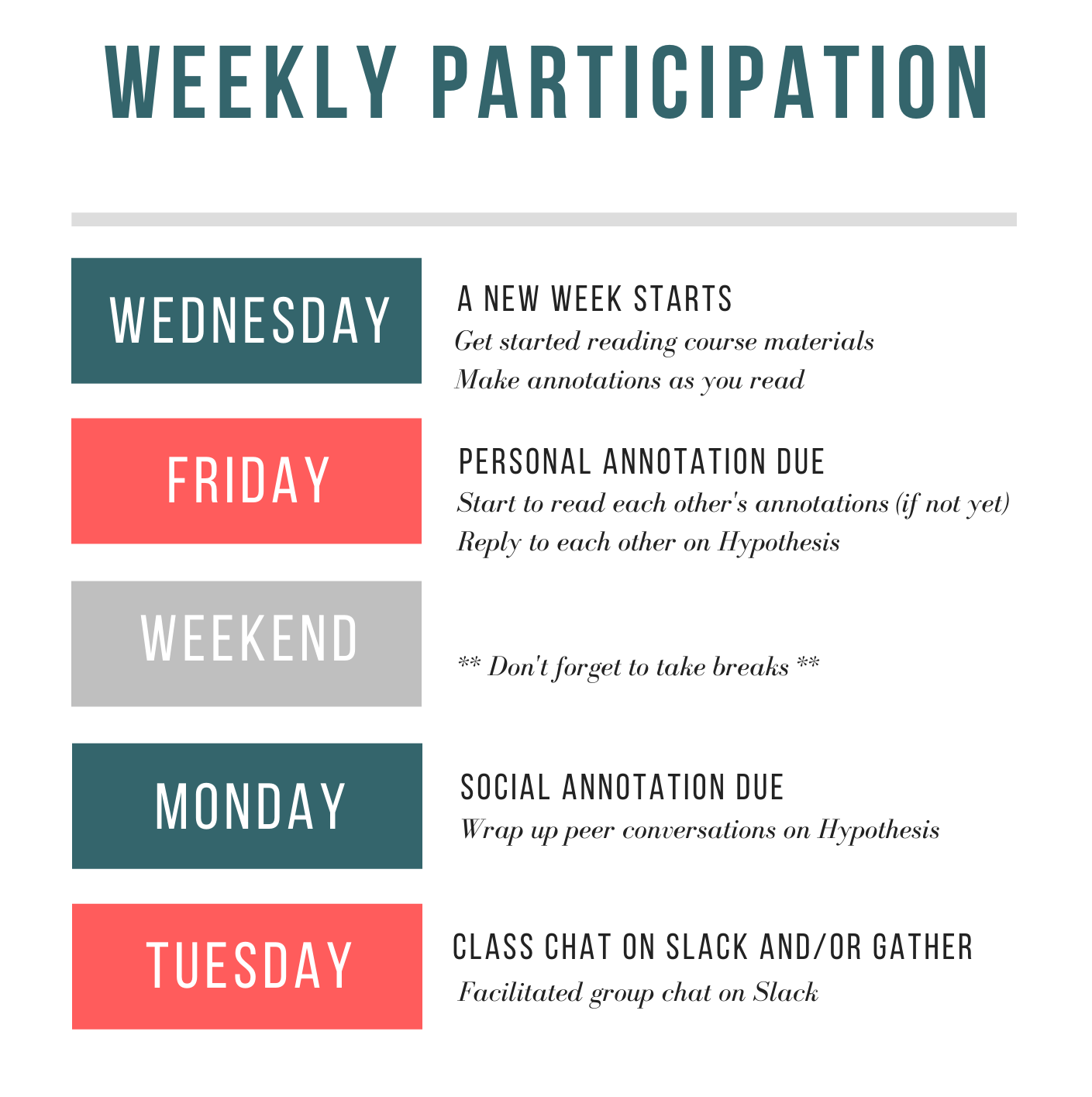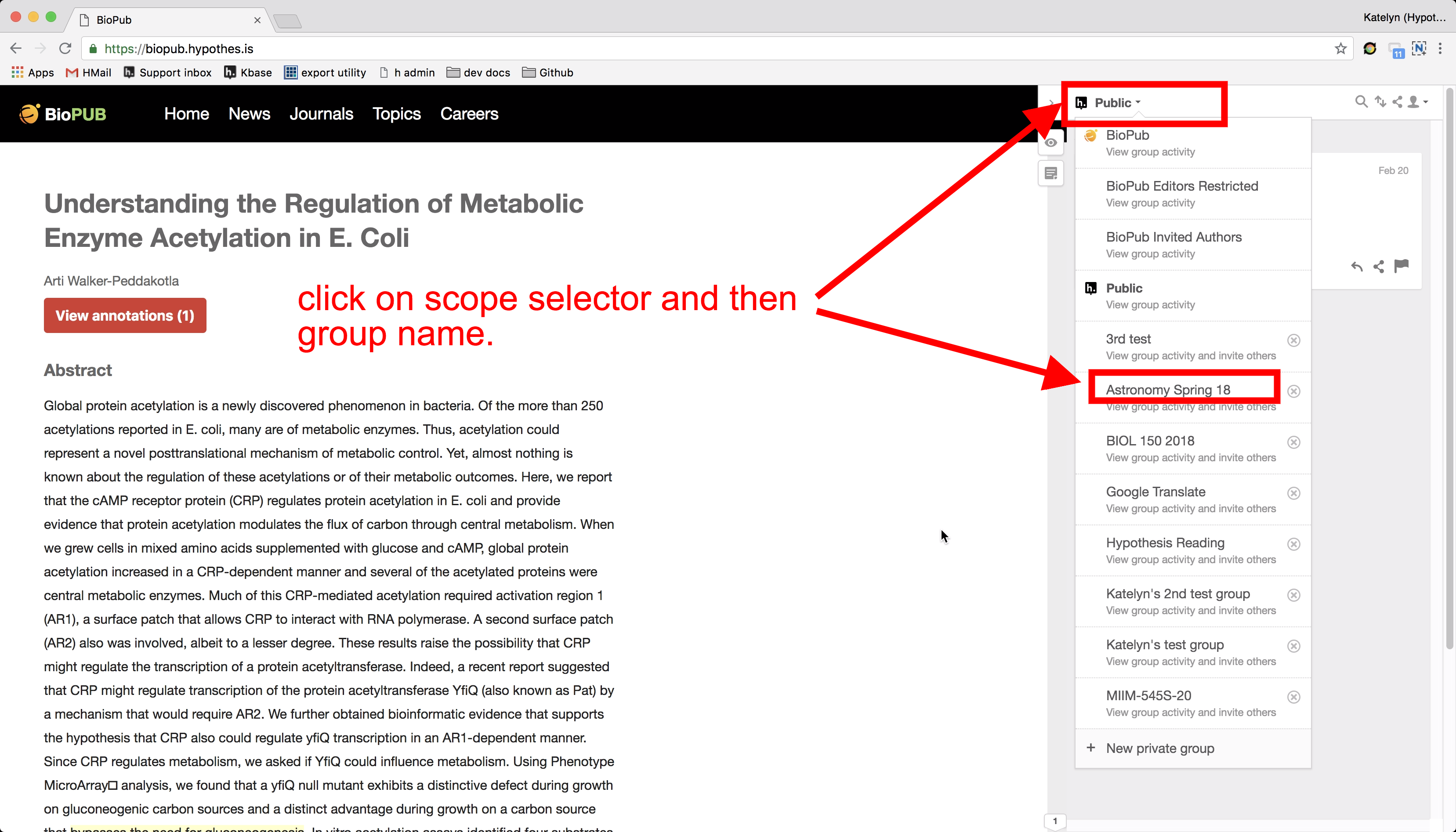Preface
Course Syllabus
The most up-to-date syllabus is here. Please leave comments on the syllabus if you have any questions.
What to expect each week?
This online class is designed to offer rich opportunities for social participation. Below is an infographic showing how a week would (typically) look like.
- Our class meetings happen on Tuesdays. The class meetings are designed for us to chat about things we’ve learned, gaps of understanding, future plans, etc. In some weeks we will meet in Gather; in some other weeks, we will “meet” on Slack throughout Tuesday.
- A fresh week starts on Wednesdays. Depending on your schedule, you can get started with course readings and begin to make annotations.
- By the end of Friday, you are expected to finish reading articles assigned for the week and post your personal annotations on Hypothesis.
- By the end of Monday, you are expected to check out what other colleagues annotated and reply to each other. You will receive an email notification when someone responds to you. It is hoped that by putting our minds together we can develop deeper understanding.
- On Tuesday, we chat more on Slack or Gather. Detailed guidelines will be posted each week.

Why not Canvas for this course?
To learn social network analysis (SNA) – and many other stuff – I believe the best way is to ‘live’ with it. That is, the best way to learn SNA is to seize every opportunity of applying SNA in one’s own learning journey. This philosophy leads to two major reasons I’m piecing together a learning environment by myself:1
- First, as an instructor I wish to foster social interaction as much as possible. Traditional learning management systems, like Moodle and Canvas, do not prioritize this goal
- Second, to practice SNA with our own ‘learning traces’, system log data2 need to be somehow exposed to users. Traditional systems are less transparent in this area.
If you haven’t used these tools mentioned above, no worries. I will provide detailed guidelines to get you started (see the next section). Many of us would be venturing out of our comfort zones. (SO DO I – because I cannot stop trying new things :-).) I hope we will all learn a great deal about SNA and beyond.
Have fun!
Two tracks of participation
This course website is openly available online, reflecting my committment to ‘open scholarship’. So there are two tracks of participation designed for this class.
- UMN class: For UMN graduate students enrolled in the class, your participation in this class is not that different from taking another online class. You are expected to meet course requirements outlined in the course syllabus. You will have private spaces (on Slack and Hypothesis) for within-class communication.
- Open participation: For ‘Open Participants’ who are following the class, you can access the same materials I curate on this website. You may need to buy the required textbook if you do not have a library access. And ways for you to participate include 1) making public Hypothesis annotations using tag
SNAEd, and 2) tweeting out your ideas or links to your blog posts using hashtag#SNAEd.
If you have any feedback on the current design, please get in touch. I’d love to hear your thoughts.
Digital learning environments
This is a fully online class. An online course does not need to be about watching videos and answering quizzes. To foster rich learning experiences, we will be using several technological tools to foster social, collaborative learning. Depending on your familiarity with these tools, there could be a learning curve. So please spend time this week to familiarize yourself with them.
Below is a list of them and we could tweak the list when moving forward.
Bookdown course site. This website you’re reading is built by myself using Bookdown. Bookdown is designed for writing books. While this site may evolve into an open textbook, I’m using it as our course portal.
Course resourses, usually organized by weeks, will be published here. Weekly course annoucements will be pushed to the class through Slack (more below). (If you are an ‘Open Participant’, just check this website every Tuesday!)
Gather. You will receive a calendar invite to all class meetings in a virtual space named Gather. It is an alternative to Zoom but gives us more options to socialize in a more organic manner. Watch the video below to get started. Check out the documentation page if you wish to learn more.
Slack (UMN Students Only). You will receive a link that invites you to join our Slack community. Course announcements are made on Slack. All sorts of class discussion will take place there as well. First time using Slack? Watch the video below and/or read this brief introduction to Slack.
To get started with Slack, get familiar with a few Slack terms you need to know [^3]:
- Messages or Updates — the basic message or status of Slack. Similar to Facebook updates, tweets, chats, etc.
- Channels — like separate rooms within the domain. They can be public or private.
- Direct Messages — like DMs or private messages anywhere else.
- Posts — longer than a status update. Similar to a blog post or a Word document. Once it’s shared to a Channel, folks can comment on it or even edit it if the owner allows.
- Snippets — Chunks of syntax-highlighted code for when that’s the thing you need to share. We might use it.
- @replies — much like on Twitter, used when you want to mention someone. You can @everyone or @channel.
- emoji — just like what you see everywhere.
- Integrations — Slack can ‘talk’ with many other systems. For example, you can post a doc from your Google Drive when submitting an assignment; you can type
/giphyto share random gifs. I will explain more later.
To learn more, check out the Slack tutorials.
Hypothesis. If you’re a formal participant, you should have received a link that invites you to join a private Hypothes.is group. Hypothes.is is a web annotation tool that enables us to discuss readings in a contextual manner. When annotating, please make sure our group name (SNAEd) is properly selected. Pro Tip: Please try to use a same (or at least a smilar) username for Slack and Hypo so that we can match you in two spaces.

If you are an Open Participant, please annotate publicly and make sure to tag your annotations with SNAEd. Otherwise, it will not be picked up by our class feed.
To learn more, check out Hypothesis Quick Start Guide for Students, and a more complete Resource Guide for Students.
Twitter (optional). If you tweet, like me, please tag your tweets with #SNAEd as well.
To demonstrate how Twitter could be useful, I bet you can learn more from TechPizza than from this course (set Topic to be, for example, ‘Text, Network Analysis’ –> ‘network:gephi’).
Google Drive. Google Drive will be used for major assignment submissions. I will provide detailed feedback directly in your Google Docs, so it is important you use Google Drive. UMN offers free Drive access and unlimited storage. If you need help, check this OIT page: https://it.umn.edu/technology/google-drive
Ways to contribute to this site
This is the 3rd time I am offering this course. By making this course site open, I hope it could be useful beyond the formal class and was thrilled see tweets like this one:
Very inspiring course book shared by @bod0ng about Social Network Analysis in Education https://t.co/w85Rf5AVs9 #SNA #SNAEd
— Marco Kalz (@mkalz) January 5, 2021
I’d appreciate your help to continually improve the site and here are ways you can contribute:
- The best way to contribute to this site is to annotate it using Hypothesis. For example, to point out a possible spelling error, you can highlight the error and include two tags –
SNAEdandissues– in your annotation. - The second best way is to report a
New Issueon this website’s Github issues page. - If you’re Github-savvy, please consider forking the Github repository, making edits, and sending me a pull request.
- If none of those options work for you, simply drop me an email at chenbd@umn.edu.
I’ve published these ideas as a design case on TechTrends if you’re interested in reading more.↩︎